- Home
- Our School
- The History of ICHS
The History of ICHS
With thanks to Andrew Emeny, History teacher at ICHS (1998-2022).
Early Years 1901-1904
At about 8 o’clock in the morning on 1st July 1901, Mr Winyard opened the gates to allow pupils into the school for the first time. Mr Winyard was the first School Caretaker and he remained at the school until 1935. In the beginning, the school was located in Balfour Road, Ilford and was known as the Park Higher Grade School. Although the name was changed a year later, Old Boys and staff of the school have continued to be known as ‘Old Parkonians.’
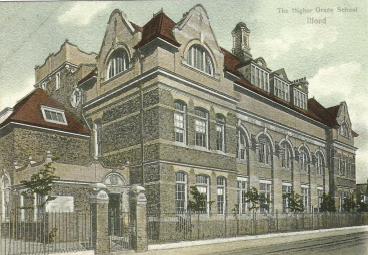
The school had been officially opened by the Bishop of Barking on Saturday 22nd June 1901. The foundation stone commemorating the opening now resides on the wall of the Staff Quad in the present school. Architect, Mr Dawson designed the building in Balfour Road on the central hall and classroom principle in three stories. Initially, the ground floor accommodated up to 300 girls in six classrooms. A similar number of boys were to be found on the first floor. Girls and boys entered through different doors and rarely mixed aside from special assemblies in the Hall and Sixth form lessons.
Soon after opening, the school was given a new title by the Board of Education, that of Ilford Higher Elementary School. When the County Council took control, they referred to the school as Essex County Secondary School, Ilford. Then in January 1908, the name was changed again, to The County High School, Ilford.
The First Inspection (1905)
Essex Education Committee inspected the school in March 1905 and wrote a report the following year. At the time, there were 471 pupils (261 boys and 210 girls). The vast majority (444) were aged 12-16 and only 7 pupils had remained beyond their sixteenth birthday. Mr C. W. Clayton was the first Headmaster of the co-education establishment. Miss A. L. M. Hunter was Senior Mistress in the girls’ department and Mr A.E. Diggens was in charge of the boys. The school provided evening classes during winter months and by 1905 had established a Pupil Teacher Centre and cookery room. Defects identified in the first inspection included the cramped cloakroom and lack of drying apparatus for wet weather. It was also felt that better dining arrangements were needed for those who did not go home for lunch. In addition, it was suggested that a gymnasium, music room and a place for the 40+ pupils who cycled to school to put their bicycles were needed along with more ‘good’ pictures in the halls and classrooms. The school had a relatively large, asphalted playground, but had to use Ilford Sports Ground for cricket and football matches and lawn tennis.
The course of instruction for boys and girls involved Religious Knowledge, English Language and Literature, History and Geography, French, Mathematics, Natural Science, Drawing and Drill. Those in the higher forms could opt for German and Shorthand. In terms of science, boys studied both Chemistry and Physics whilst girls took a combined course covering Botany, Chemistry and Physics. Boys were taught woodwork and girls had lessons in music, cookery and needlework. There were plans in 1905 to introduce Latin for those in their third year at the school. Discipline at the school was described as ‘good’ and the Drill ‘excellent.’
The inspector reported that, ‘Ilford is not an industrial district and it is probable that the majority of the boys will, like their fathers, be subsequently engaged in some form of business or trade.’ It was noted that many parents thus wanted their sons to be taught Shorthand rather than Woodwork. The school was prompted to encourage more boys to take the London Matriculation Examination and proceed to university. It was also commented upon how the girls were encouraged to enter the teaching profession through the newly built Pupil Teacher Centre. Indeed, in 1905, 88 girls and 14 boys were training to become teachers at the Centre. The Teachers’ Centre role at the Melbourne Road/Balfour Road site continued to aid the training of new and existing teachers for a further 100 years.
In 1905, teachers’ salaries at the School ranged from £105 to £200. The cost of teaching pupils was worked out as £12.10s per head. Each pupil paid £3.3s. per year and the Local Authority had to subsidise the rest of the cost.
In December 1905, Mr Clayson resigned and his post was discontinued. The boys’ and girls’ departments were separated and each had their own dedicated staff and Head teacher. Mr Diggens continued as the Head of the Boys’ School (until 1936) and Miss E. E. Morris took over as Headmistress of the Girls’ School.
In the Winter of 1909, Evening Classes were expanded to provide courses in Art (including costume life class), Hygiene, Building Construction, Woodwork, Shorthand, Book-keeping, French, German, Commercial Arithmetic, Cookery, Dressmaking and University extension lectures. Course fees were between 3 and 5 shillings.
The House system was first introduced in 1909; the six Houses being Cranbrook, Seven Kings, Loxford, Hainault, Clementswood and Park. Pupils joined the House corresponding to the ward from whence they came. Park subsequently changed their name to ‘School House.’ In 1912, the Houses were changed to Abbey, Forest, Castle and School. The House system fell out of use sometime in the 1970s. For many years since, the letters P, Q, R and S were used to distinguish forms. In recent years, the House System has been re-established following a student’s suggestion that Bird of Prey names be used. Currently, there are Eagles, Falcons and Hawks Houses. Osprey House existed before the School moved from four-form entry to six form entry.
The school made the national press in June 1914, when a student tried to claim damages after an experiment in Science. The foolish lad had decided to put some phosphorus in his trouser pocket and shortly after had felt an intensely painful burning. Clearly Health and Safety regulations were less stringent at the time. His claim was literally laughed out of court.
The First World War 1914-1918
The School magazine, Chronicles, was first published in 1911. The magazine for the Summer Term, 1914, gave no hints of the impending war or the devastation that was about to visit the school and thousands of other schools. It featured a photograph of the school’s highly successful Athletics Team. They had just won the Champion Russell Cup for the third time in succession.
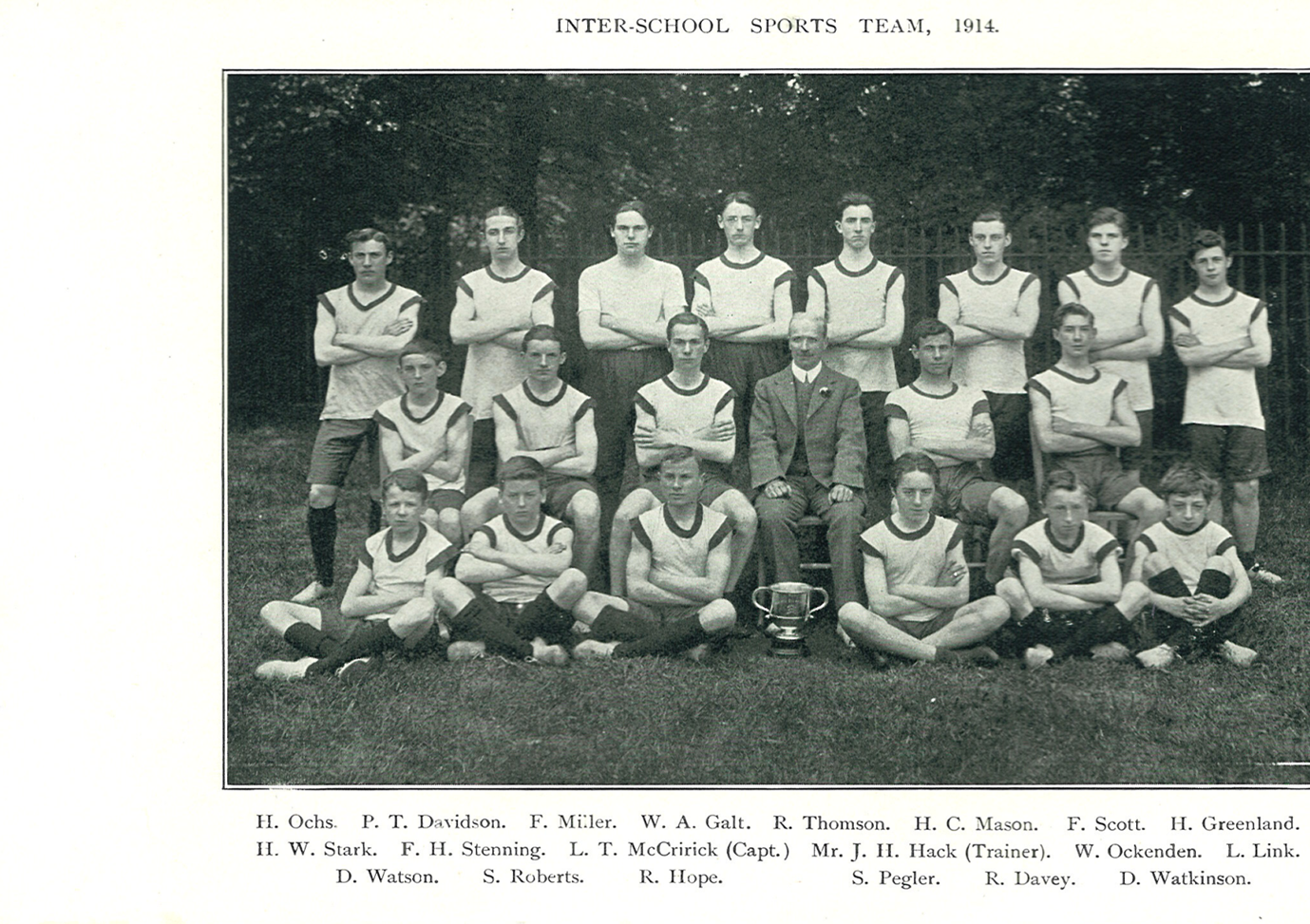
Mr A.E. Diggens, the Boys’ Headmaster and editor of the magazine glowed with pride in his editorial at this success. Sadly, within four years of publication, three members of the team would be dead and several others injured as a result of the First World War. Their names would join 111 other Old Boys’ and teachers’ names upon the school war memorial.
The Christmas 1914 edition of the school’s magazine, the first ‘war number’ proudly boasted that there was a great response to the call to arms made by the Old Boys. The Roll of Honour of those already enlisted, published in Chronicles, included 229 names. Of the 65 players in the Old Parkonians’ football teams, 43 were with the colours. By the Summer of 1915, the Roll of Honour list had risen to 327.
The subsequent editions of the school magazine were dominated by news of Old Boys’ training and exploits at the front and extracts from letters home. A large number of ICHS students joined the newly formed Royal Flying Corps. This was dangerous and a great number of them died during training exercises.
Humour, optimism and patriotism still prevailed in 1915, with the school magazine featuring the following spoof telegrams, supposedly received by the Old Boy’s Association in response to invites to their annual dinner at the “Cauliflower” pub in Ilford.
“No Fed up. Besides, shall see enough of O.B.s in Berlin in the near future.-Wilhelm.”
“Busy cooking Kaiser’s goose.- Kitchener.”
“Duties prevent me.- Lloyd George.”
When the air raids started, the police turned the school into a night-time public shelter and made Mr Winyard the Chief Steward. Sacrifices were made by the school’s rifle club, who had their two best rifles requisitioned for the war and suffered due to the rising price of ammunition. The girls of the school stopped sending form notices to the editor of the magazine in order to allow more space for war news.
Although the Headmaster never wearied of reporting news of Old Boys’ heroism, by the Summer of 1916, it was noted that there was, ‘an almost complete stoppage of letters from the fronts.’ Five former members of the school died during the Battle of the Somme and the list of fallen grew month by month. As the school had only opened in 1901, nearly all of the old boys who died in the war, did so as batchelors and under the age of 25.
Henry Whittingham was the first old boy to be reported as ‘killed in action’ on February 21st 1915, aged just 18. Two wounded ex-students visited the school in the Spring term of the same year, R.C.J. Smith and E. Bateman. Occasionally, deaths were written about euphemistically in the school magazine, for example, ‘Eric Sauer has followed Fred. Miller to the rest camp whence no warrior returns to the firing line.’ By mid-1916, the word death was rarely used and instead soldiers were said to have ‘fallen,’ or ‘been lost.’
By Spring 1917, a cadet corps had been established in the school and over 500 War Savings certificates had been purchased by students.
A remarkable story of heroism from an ICHS Old Boy.
In February 1918, the British merchant ship, the S.S. “Dom Miguel de Larrinaga” was homeward bound with grain from Vancouver in Canada to a French port. During the food shortages and rationing of early 1918, the safe transport of grain was of vital importance to the Allies. Old Boy of the School, Harold Wadham was a gunner on board this vessel. The boat hit terrible weather, and the cargo shifted. Repairs were attempted, but the rudder-pole broke and she became completely helpless before a hurricane. The captain ordered the crew to the lifeboat, but it could not take them all. The captain then asked for nine volunteers to surrender their places and remain with him on the half-submerged vessel to enable the rest of the crew to reach safety. Immediately, Harold Wadham stood beside his captain with two officers and six men. The 27 men in the lifeboat were rescued by a warship, and although the ten heroes on the doomed vessel sent up rockets for 40 hours- the last at 3.a.m., February 5th- when the warship arrived on the spot at dawn, only wreckage was found.’
Lord Knutsford, chairman of the London Hospital, to whom Harold left a legacy in his will, summed up the heroism of his last hours;
‘We can imagine those last 40 hours- the calm courage, the deep satisfaction, the carelessness as to whether the world ever knew of what they had done- and amidst this the rockets going up. Those rockets, in all likelihood sent up by Gunner Wadham, are the beacon lights to the School for as long as it stands. They speak from the tempests of mid-Atlantic of all that is greatest in human life.’
Pupils and Staff of the school commemorated this heroism each year with a fund-raising effort on behalf of Harry Wadham for decades after.
Other stories from ICHS and the war
George. D. Moore’s diary for 1916 is kept at the Imperial War Museum. It charts his thoughts from being called up to enlistment at Warley Camp and provides an intriguing insight into the process as well as the difficulties faced by young men trying to establish themselves in a career, start a romantic relationship and reconcile the war with their strong-held religious beliefs. He enlisted on 6th November 1916 and spent his days prior to this at prayer meetings, negotiating with his employer for an allowance to supplement his army pay and comforting his girlfriend, Gladys. On the day he left for war, Gladys gave him a wristwatch with a luminous face and religious verse.
George described the crowds that saw the train off, how he packed items like writing paper, shaving things and chocolate, and how Gladys had cried.
One of his final entries was the following;
“On the train I felt lonely. I prayed for companionship and that we might all come home.”
The first wish came true, he met another old boy of ICHS, Hobdell, and they remained together for the journey. However, George was never to return home- to rejoin the bank or marry his sweetheart, Gladys. He was killed on 26th October 1917 (the first day of the second battle of Ypres [Passchendaele]) and is commemorated on the Tyne Cott Memorial near the town of Ypres.
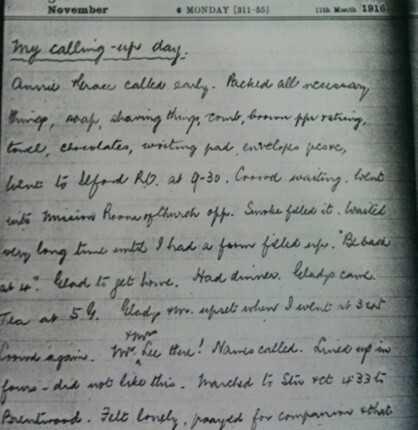
Extract from G.D. Moore’s diary courtesy of IWM.
Edgar and Percy Armstrong attended the school and were both killed during the war. According to Chronicles, Percy was right beside his brother, when Edgar died at Gallipoli on 4th May 1915.
‘Just as Percy had wormed his way across an open plateau with some rations and had reached his brother’s side in the trench, a sniper’s bullet, evidently intended for Percy, killed his brother instead.’
Percy was invalided home shortly afterwards, with dysentery. He made a good recovery and was sent on board the ‘Indefatigable’ alongside fellow Old Boy, Oliver Cocks. When the ship was sunk, it left only one serving brother, George alive.
In May 2015, William Cuthbert, nephew of Edgar and Percy Armstrong, visited the school and shared the above story and photographs with the school. He also placed a small cross by the School Memorial to mark 100 years after Edgar’s death.
Leon Louis Lailavoix was one of two former teachers at the school, who died in the Great War. The other was Samuel Porter. At ICHS, Monsieur Lailavoix taught French Language and Literature to Forms II a, b and c as well as Form III. He had a strong interest in English Literature and in 1913 published a book in French about Geoffrey Chaucer.
Details on the University of Manchester’s roll of honour reveal the following about his time in the French Army. On the outbreak of war Louis obeyed the call of his country, joined the French Army and was mobilized as a Soldat de 2nde Classe on 12th August 1914. He was promoted to Sous-Lieutenant in April 1915 and died during a defensive battle around Côte (hill) 304 near Verdun 12 months later. In 1921 he was posthumously awarded the Croix de Guerre for conspicuous valour during the Battle of Verdun.
In the Summer 1916 Chronicles magazine, the headmaster wrote the following tribute in his editorial;
‘Monsieur L. Lailavoix is dead. Old Boys who studied French in his classes have the liveliest recollections of him, and they roar with laughter when they think of the French farce which he wrote for one of the prize-givings. He wrotes the “book,” he arranged the music, and he was a restaurateur in this lively piece, which “featured” a wedding procession, a ball – and many soda-water siphons. The siphons were very effective. It was a great blow when he left us to become a Professor of French at Manchester University. More than a year ago there was a picture of him in an English illustrated paper, picking pieces of shrapnel out of his knapsack. Now he has fallen. If there are many Frenchmen like our former French Master, France must indeed be unconquerable.’
Biographies for all of the Old Boys and teachers from ICHS who died during the First World War can be found on the Redbridge Museum First World War website.
https://redbridgefirstworldwar.org.uk/memorials/ilford-county-high-school-memorial-plaque
The School Memorial
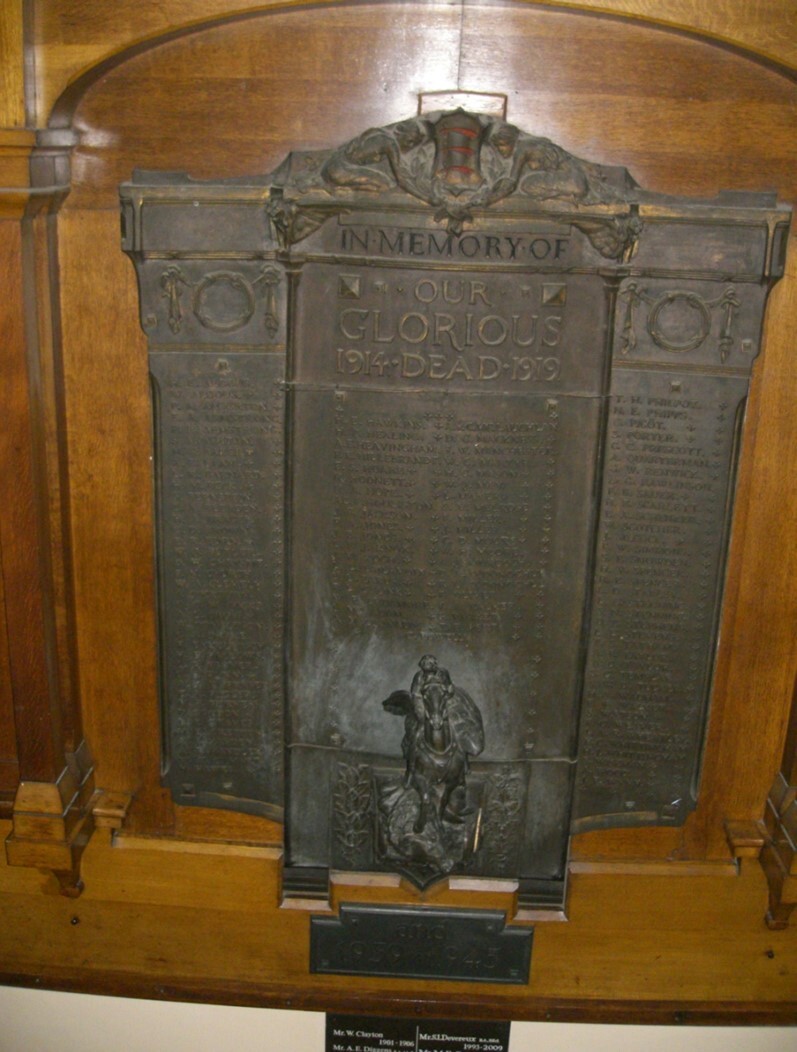
Photograph courtesy of A.Emeny.
During 1919, when many were still suffering the effects of rationing and shortages, ICHS parents, teachers and governors raised over £170 (about £12,000 in 2023 money) and the art teacher, Nehemiah Vinall was asked to design a centre piece. Mr Vinall had a club foot and was severely lame and thus could not serve in the war himself. As a result, he was determined to play a part in the peace and act of remembrance. His daughter wrote a memoir that is held at the Essex Record Office in Chelmsford.
According to Mr Vinall’s daughter:
“He sculptured the entire piece in his studio in Quebec Road. The plaque and the horse symbolising peace. It was sent away to an iron foundry in Germany and was cast in bronze. When it was returned, he spent many hours, cleaning the bronze flashing from all the boys’ names. It was unveiled on 9th December 1920.”
It is amazing, but perhaps strangely appropriate for a sculpture piece named “the victory of love over war” that the sculpture was sent to Germany to be cast when Britain had only recently fought a war with the country and the memorial commemorated soldiers predominantly killed by German citizens. Mr Vinall was showing both an element of forgiveness as well as reconciliation. Love was triumphing over war.
When the headmaster of the school unveiled the war memorial, there was a Roll of Honour as all the names were read out, the last post was played by three buglers and there was a two-minutes silence. The School continues to mark the anniversary of the end of the war in a similar way, with Year 8 pupils reading the names of the fallen in both World Wars. The Headteacher, in 1920, recorded in Chronicles that after the Roll of Honour was read, “we resumed our work, silently rejoicing in the fact that we had at least given two minutes thought to those who gave us their all!”
The Interwar Years
School life soon went back to normal after the end of the war and school clubs and sports started again. The Cadets and Swimming clubs restarted in 1918, followed by Chess Club (1919) and a girl’s debating society (by 1922). The Chess Club had originally been established in 1912 by Mr Hack. It played its first inter-school match (against Coopers’ School) in 1916 before being suspended so that members could spend more time in the Woodwork shop making apparatus for the Emergency Hospital. Incidentally, the match against Coopers ended in a narrow loss (7-5 and 6-4).
The inter-war period saw the setting up of many new extra-curricular clubs including the Geographical Society, Natural History Club and Magic Lantern Club. In addition, the Old Parkonians Lodge was established in 1929. In addition to various excursions by members of these clubs, the school began a tradition of Summer camps. The first took place in 1930, when 64 boys spent time doing outward bounds activities and visiting local sites of interest near to Conway, in North Wales. Subsequent summer camps took place on the Isle of Wight, Cornwall and Staithes.
In terms of sports, the school re-established its dominance of local athletics and continued to win the Champion Russell Cup on a regular basis. However, the traditional popular sports of cricket, football, swimming and tennis were joined by new ones such as boxing and cross-country running in the 1920s.
By the late 1920s, the boys were housed on the ground floor and the girls occupied the first floor. The top floor was where science and art lessons were held. However, one former pupil described how this meant that the chalk drawings suffered depredations from the neighbouring chemistry gases.
Mr Diggens (the Headmaster) presided over daily school assemblies in the hall at 8.45am, where the platform was backed by the bronze war memorial. Assembly normally involved a hymn accompanied by a piano (played by a sixth-former). After assembly, pupils had four morning classes of 45 minutes. There were no school meals, so most pupils went home for lunch or ate their sandwiches in the schoolyard. The hall was used for Physical Training and music/singing and had horizontal beams, climbing ropes and a couple of leather covered horses.
New schools, new beginnings 1929-35
In 1929, the Girl’s School moved to a new school in Cranbrook Road, by Valentines Park (now Valentines School).
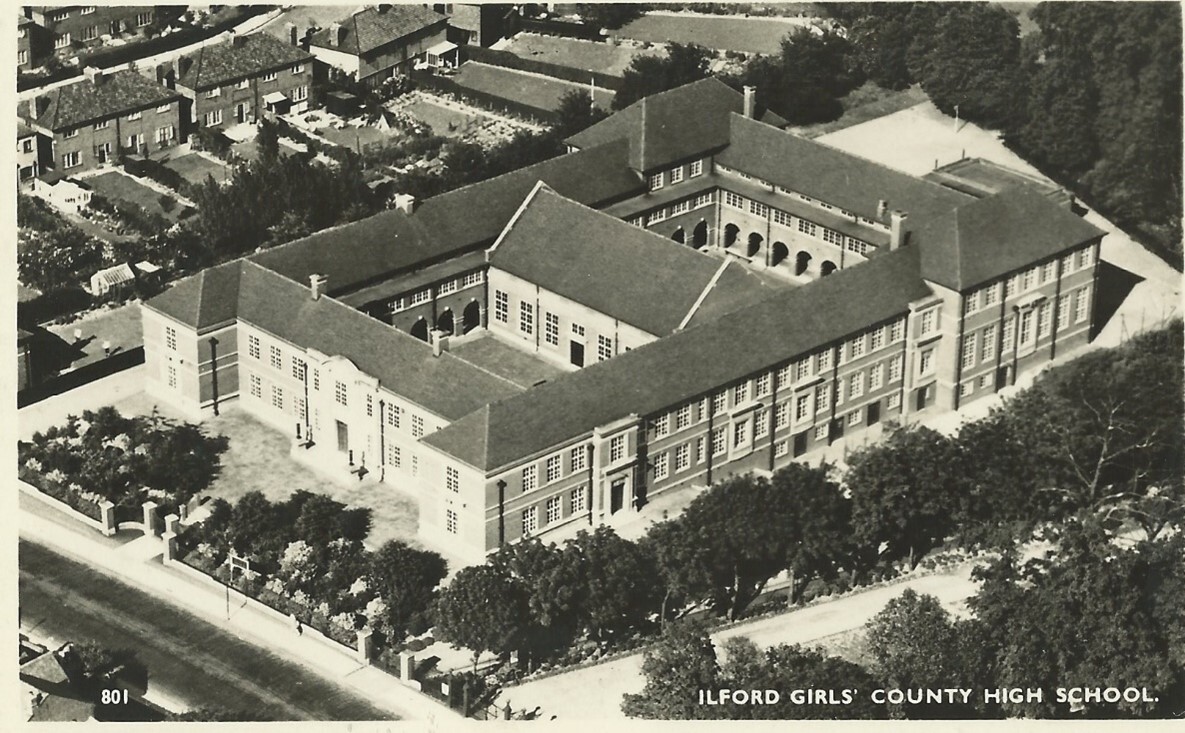
Postcard courtesy of A.Emeny
Although the Girls’ School move had provided more space for the Boys’ School to expand, they were soon to be forced to move too. The lease of the old site was cancelled in 1932 and this forced the Education Authority to find a new site for the school. Land was found in Barkingside at the cost of £425 an acre and construction began. In 1935, the new Boy’s School was completed in Fremantle Road, Barkingside, as part of the new Clayhall Housing Estate. The New County High School officially opened on 30th May 1935, having cost just over £46,000 to build. It could accommodate 620-660 boys in 18 classrooms. As well as the usual rooms and Hall, there was a purpose-built library, Physics laboratories and a self-contained flat for the caretaker, above the gymnasium. There were also ample sheds for storing bicycles.
In the Summer 1935 edition of Chronicles, the headmaster commented on the preparations for opening and his initial thoughts on the new site. He remarked on how the moving of furniture and resources had taken place without a hitch, but that it had taken a week to remove and reassemble the science gear. He described the new home as ‘a beautiful building, not without its faults and eccentricities, of course, but beautiful and commodious in most respects.’ The War Memorial was moved to the Barkingside site along with the Foundation Stone (now in the Staff Quad).
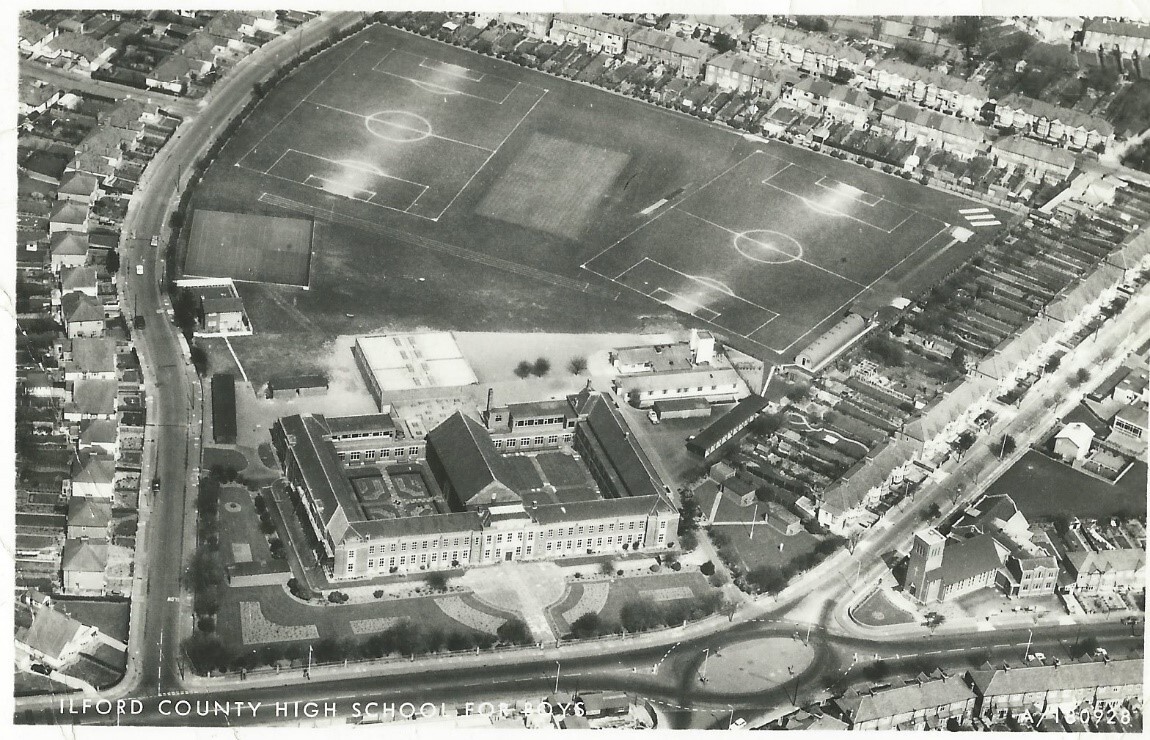
Postcard courtesy of A. Emeny
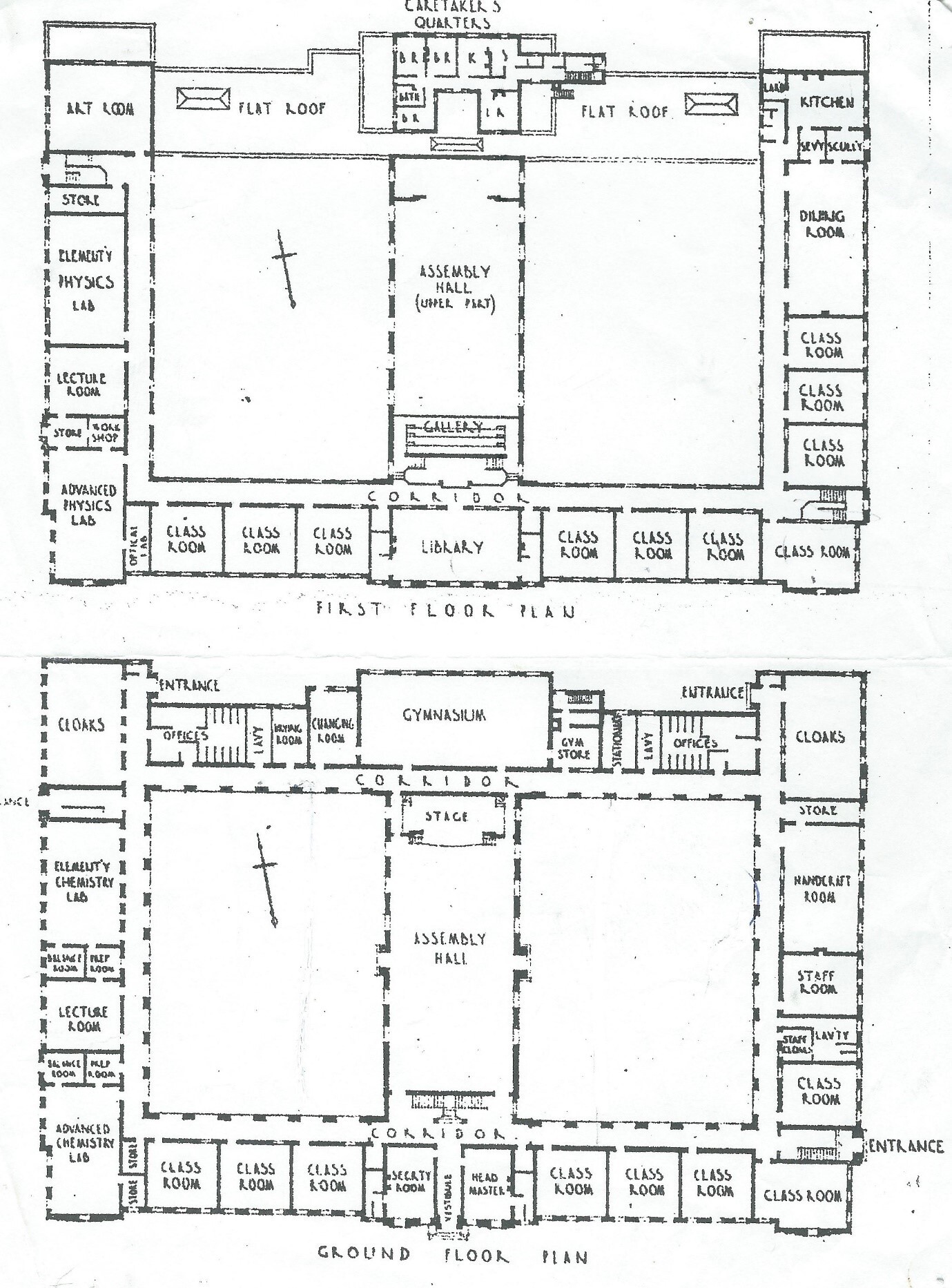
The plan of the new school shows the original use of rooms-taken from Chronicles.
The Coming of War at ICHS 1933-1939
The boys and staff of ICHS were in line with the attitude of most of the general public in the early 1930s; there was a sense that war should be averted and peaceful resolutions sought to conflicts. In this spirit, the ICHS branch of the League of Nations Union (L.N.U.) was founded in 1931. By 1934, it was the largest and most active of the School societies. Regular minutes were kept by the club’s secretary and these remain in the School’s archives. In the early years, 250 boys, almost half of the school’s population regularly attended its lectures, often led by Ambassadors, Civil Servants and experts from across the globe. Regular debates were held. Initially, these featured broad topics such as the role of censorship and developments in the Far East and Pacific. However, in the wake of Hitler’s appointment as Chancellor of Germany in 1933, the focus moved to the impact that this would have upon European affairs. On February 8th 1934, Dr. G.E. Neumann spoke on the subject of ‘Germany’s attitude to the League of Nations.’
Debates during the 1934-5 academic year, mirrored the national mood for disarmament and appeasement. The Society debated whether the expansion of the Air Force was justified, the pros and cons of Conscription and the motion that ‘armaments do not afford security.’ In the same year, a debate with the Girls’ School addressed the issue of whether Fascism was an improvement on democracy. The large majority voted that it was not!
New books were added to the L.N.U. Library in that year too. Including Beverley Nichols’ ‘Cry Havoc’ and A.A. Milne’s ‘Peace with Honour.’ The former was a bestseller in 1934, but has since been described as ‘pacifist propaganda.’ In ‘Peace with Honour,’ the author of Winnie the Pooh takes on the weightier issue of whether war is a valid method of resolving international conflict. Clearly, the mood of the ICHS L.N.U was for peace.
As the 1930s progressed, the school’s branch of the L.N.U followed the events of the Italo-Abyssinian dispute and defeated a motion in favour of Italy’s actions by 37 votes to 3. However, the mood was gradually changing and a majority carried the motion (during an inter-school debate with Barking Abbey School) that ‘Isolationism is an impracticable policy at the present stage of civilisation.’
Indeed, 1936 saw a number of debates questioning the role and case for the League of Nations, perhaps showing rising doubt over the organisation’s effectiveness in light of challenges from Japan, Italy and Germany. Furthermore, one debate that took place proposed the motion that ‘the League, in its present state, is a menace to World Peace.’ The motion was lost by 7 votes to 24.
By the Spring of 1936, membership had fallen to 100 despite 200 students signing up at the start of the academic year. The programme continued the form of lectures advocating peace and debates questioning whether rearmament and an abandonment of the League might be wiser. By the start of the following academic year, the enthusiasm for the L.N.U. had truly diminished and they barely achieved one hundred sign ups. Discussions continued over the need to reform the League and motions favouring disarmament over rearmament still carried the day (just). However, by the start of 1938, the zeal for the League and the desire to debate issues were clearly waning. Despite this, membership picked up a little and resolutions were carried in support of Abyssinia and China in light of their invasions by Italy and Japan.
It is interesting to note that little attention was given to events in Germany until the Spring of 1938, when a discussion was held on the German demand for colonies.
The Autumn 1938 report by the L.N.U. began by stating that ‘despite the misfortunes which are darkening over the League of Nations itself…we have had a most successful term.’ During the ensuing year, a lantern lecture was given on ‘Germany and Austria’ in the wake of the Anschluss and focus turned almost exclusively to European affairs and the need for ‘Collective Security.’ In a debate with Barking Abbey School, the motion was passed to welcome refugees (presumably including Jews from Germany). In her autobiography, former ICHS for Girls pupil and author of Carrie’s War, Nina Bawden, wrote of how the school welcomed German Jews during the Kindertransport. There is no evidence in the School Register that any boys from the Kindertransport attended the Boys’ School though.
In the Summer Term of 1939, the L.N.U. was reportedly suffering from a lethargy. It still organised the Empire Day Tea and a trip to the Houses of Parliament. However, the enthusiasm for debating world affairs had gone. It was hoped that, ‘support for the League of Nations will not decay through lack of energy or energy.’ By the time that the Autumn 1939 edition of the School Magazine was received by subscribers, war would have already been declared. The League of Nations’ report consisted of an account of the L.N.U Camp in Devon (which had been attended by two members of the ICHS branch). Despite delegates from across the globe, it appears that the camp involved more camp-fire sing songs and folk dancing than political discussion and lectures.
By the time that the Spring 1940 magazine was printed, the School population had dispersed- many evacuated to Ipswich- and thus the L.N.U. reports and activities ceased. The Second World War, the ultimate indicator of the ineffectiveness of the League of Nations, finally ended optimistic hopes of collective security, splendid isolationism and peace without war.
1936-end of the Diggens’ Era and a new headteacher.
Mr Diggens retired as Headmaster in 1936 and was replaced by Mr H. S. Kenward (who remained in post until 1966). Mr Diggens’ final year was one of the most successful in the School’s history as the Athletics team won the Champion Russell Cup for the twelfth time, the Chess team won the London Cup, School’s branch of the League of Nations Union won the Sherman Shield, the Swimming team won the local meet and the Dramatic Society put on a fine performance of Twelfth Night-all on top of a splendid record of academic achievement. Sadly, Mr Diggens died in November 1937.
The School at War 1939-1945
The School at war- evacuation, air-raids and war work 1939-45
Evacuation from CHSI to Ipswich
At the end of August 1939, plans were drawn up to evacuate the majority of students from Ilford’s schools. On 1st September, trains left Ilford Station, carrying children to Suffolk and Somerset. ICHS boys were taken to Ipswich, in Suffolk.
In the Autumn 1939 edition of Chronicles, the school magazine, the relatively new headmaster described the evacuation to Ipswich as ‘a tremendous task.’ The school had re-assembled in late August 1939 for a frantic week of preparations.
Billeting was described as the most difficult aspect of evacuation. However, with very few exceptions, all boys were found comfortable accommodation, living with kindly foster-parents. Most were within a short walk of their new school, Northgate School. Even so, lessons still ended early in the afternoon so as to allow boys to reach their billets before the Autumn nightfall. Nocturnal wanderings were discouraged.
Each district had a master allotted to supervise and look after the boys in that area. Not everyone’s experience was happy though. The Spring 1940 Chronicles included an article in which it stated that;
‘Some boys were exceedingly fortunate in their billets, as is shown by the large percentage of boys who have not changed their original addresses. Others have not been so lucky, and are still continuing their weary journey through Ipswich homes. Although some foster-parents have not behaved in the nicest manner to the “scaterees,” those who have provided comfortable billets and a warm welcome have received the cooperation and gratitude of their guests.’
Some boys returned to Ilford and their homes during the Phoney War period- when it became clear that an invasion or attack on London and the South-East in late 1939 or early 1940 was unlikely. For Kenneth Sharpe, this decision would prove fatal. In the September 1939 Register, he was living with the Watson family in Ipswich. Tragically, he died in Ilford during an air raid on 9th October 1940. A high explosive shell hit his neighbours’ empty house at 41 Otley Drive, Ilford and the blast killed Kenneth, his sister and both parents in their home at no 43.
Northgate School was relatively small compared to ICHS, normally catering for 200 students (both boys and girls). ICHS, on the other hand had about 700 boys on roll.
Billeting in Ipswich for nine months gave the boys a chance to explore the industries of Ipswich, sites of Constable Country and abundance of wild birds of Suffolk during bicycle rides and guided walks. Norman Barnett of Va wrote at length in Chronicles of his adventures with other ICHS cyclists and ramblers. Sadly, Norman died in Aldershot, aged just 20, on 7th May 1944. He had only enlisted a matter of weeks before with the Royal Army Service Corps.
For many ICHS pupils, Christmas 1939 was spent in Ipswich and boys were reportedly subdued when told that they would not be able to spend it back in Ilford with their families. The masters were to stay too and organise the Christmas entertainments. Spirits rose when the programme of festive events was announced. These included the Mayor’s Tea Party, cinema performances and visits to sites of interest. On one day, Wednesday 27th December, all Ilford evacuees in Ipswich were treated to a morning performance of “The Scarlet Pimpernel” and other short films at the Odeon cinema. This was followed by an afternoon spent touring the Evening Star and Mercury Printing Presses. The printing process was explained and some boys left with a die bearing their name.
The Mayor’s Tea, held at the Public Hall, Westgate Street, was the highlight of the Yuletide festivities. It involved a ‘splendid tea’ and concert- tame by modern standards, perhaps, but considered ‘a very good time’ by all accounts. Mr Raine held parties in his house for the boys, taking a half of the number each evening (approximately 25). These evenings included billiards, party games and yet more tea!
For the more active, a long walk to Westerfield (about 2 miles away) and back was organised (with sandwiches) and a trip to the local seaside town of Felixstowe.
Whilst at Ipswich, the boys completed the hard work of digging, ploughing and planting an allotment garden, only to leave it before the harvest was borne. In an article entitled, ‘The Allomenteers’ Lament’ two fourth form students reflect on their ‘gnashing of dentures’ at the thought that the Northgate School pupils would reap the fruits of their hard labour. They bequeathed their former hosts two hundred rows of potatoes, along with rows of cabbages, spring onions, peas, lettuces, broad beans, radishes, turnips, spinach, brussels-sprouts, parsnips, carrots and rhubarb.
With hindsight, Ipswich would appear an illogical reception area for evacuees- perhaps more likely to be targeted by the Luftwaffe than Ilford! This was acknowledged in the Spring of 1940 (as the Phoney War gave way to the real threat of a German invasion in the wake of the military evacuation from Dunkirk). Thus, on 19th May, the boys of ICHS bid farewell to their East Anglian hosts and boarded trains destined for South Wales.
The first five days were spent at Pontycymmer. The reception they received from the locals was magnificent; the streets were lined with welcoming crowds and friendly faces awaited the lads at every doorway. Sadly, the former mining village could not cater for the School’s educational needs. Therefore, the boys moved on to Aberdare where they could share facilities with Aberdare County School for Boys. The welcome by the locals was described as ‘quite as heartening’ as that received in Pontycymmer.
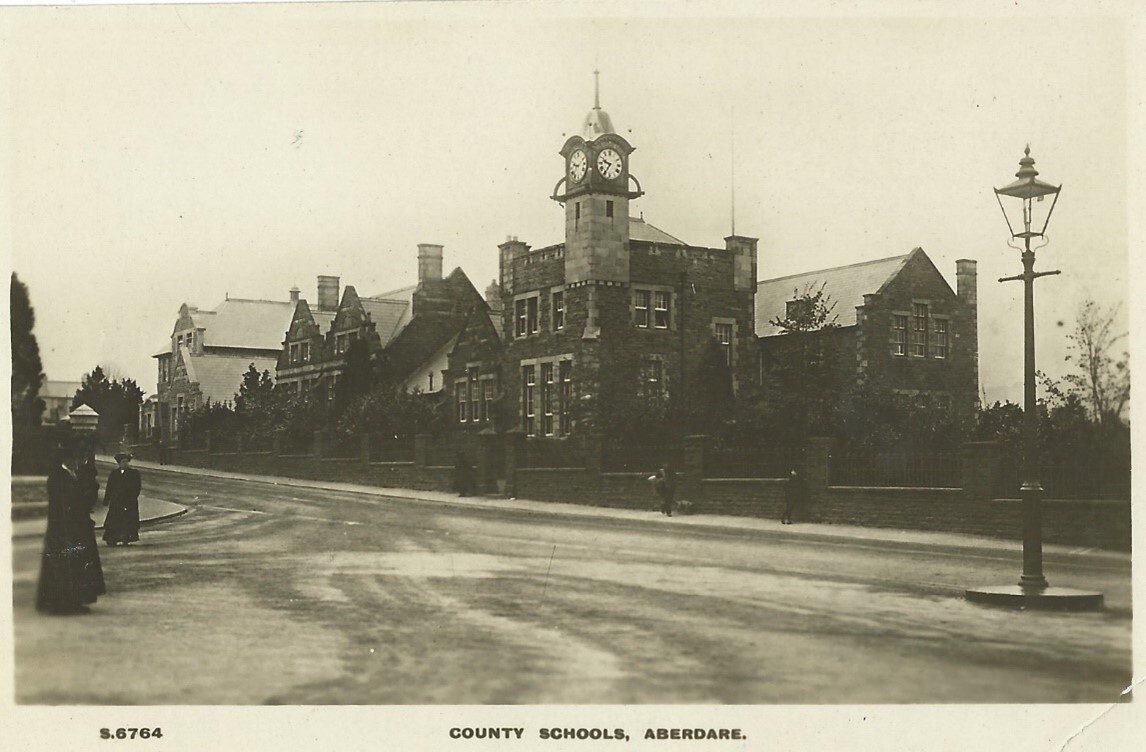
Aberdare School c.1905. Postcard courtesy of A.Emeny
Three nearby chapels volunteered the use of their vestries as temporary classrooms for the Ilford boys. The local churches of all denominations welcomed ICHS with special services, rambles, teas and other entertainments.
At Aberdare, a full timetable was followed and the school day extended from 8.45 a.m. to 4.45 p.m., with a ninety-five minute interval at mid-day.
By the autumn of 1941, the evacuees had been well established at Aberdare. Many had spent over a year and a half there. The experience had opened the boys’ eyes to the industrial life of the country and the ‘hazards of unemployment, the toil of the mine, the injustice of life.’ Suburban ways had been replaced by the ‘simple, real life of the valleys, and the mountains; of the earth, of nature,’ as A. H. Aldous, the Chairman of the Magazine Council put it. There was a youthful hope of a greater togetherness and addressing of social inequalities amongst some of the school community, who had been affected by their experiences.
New allotments were established at Aberdare, remarkably unaffected by the hardships experienced in Ipswich. The Winter weather was favourable, and no picks or forks were needed to break the ground. Even so, the work was often back-breaking as they followed the principle of double-digging. The 1941 harvest was particularly plentiful. This included, ‘a large, clean crop of potatoes, an immense yield of peas and beans (which were still being gathered at the beginning of November), hundreds of onions, very large parsnips, and a considerable quantity of swedes, turnips, carrots, beetroots, leeks, cabbages, and broccoli.’ There were, as any vegetable grower would expect, some disappointments though. The brussels-sprouts did not survive a storm and the spinach went out of control and to seed before it could be harvested. Overall, the allotment netted the boys £30 in profits. This was over and above their own needs and ‘armfuls’ that were distributed free.
More records and stories of the evacuation to Aberdare can be found on Aberdare Boys’ Grammar School website- www.abgs.org.uk.
Not all pupils were evacuated to Aberdare. Many stayed in Ilford and so there were two schools and two versions of Chronicles for a time. The photograph below shows both the numbers who had returned to Ilford by 1941 and the continued popularity of Chess at the school. The School Hall is recognisable in this photograph:
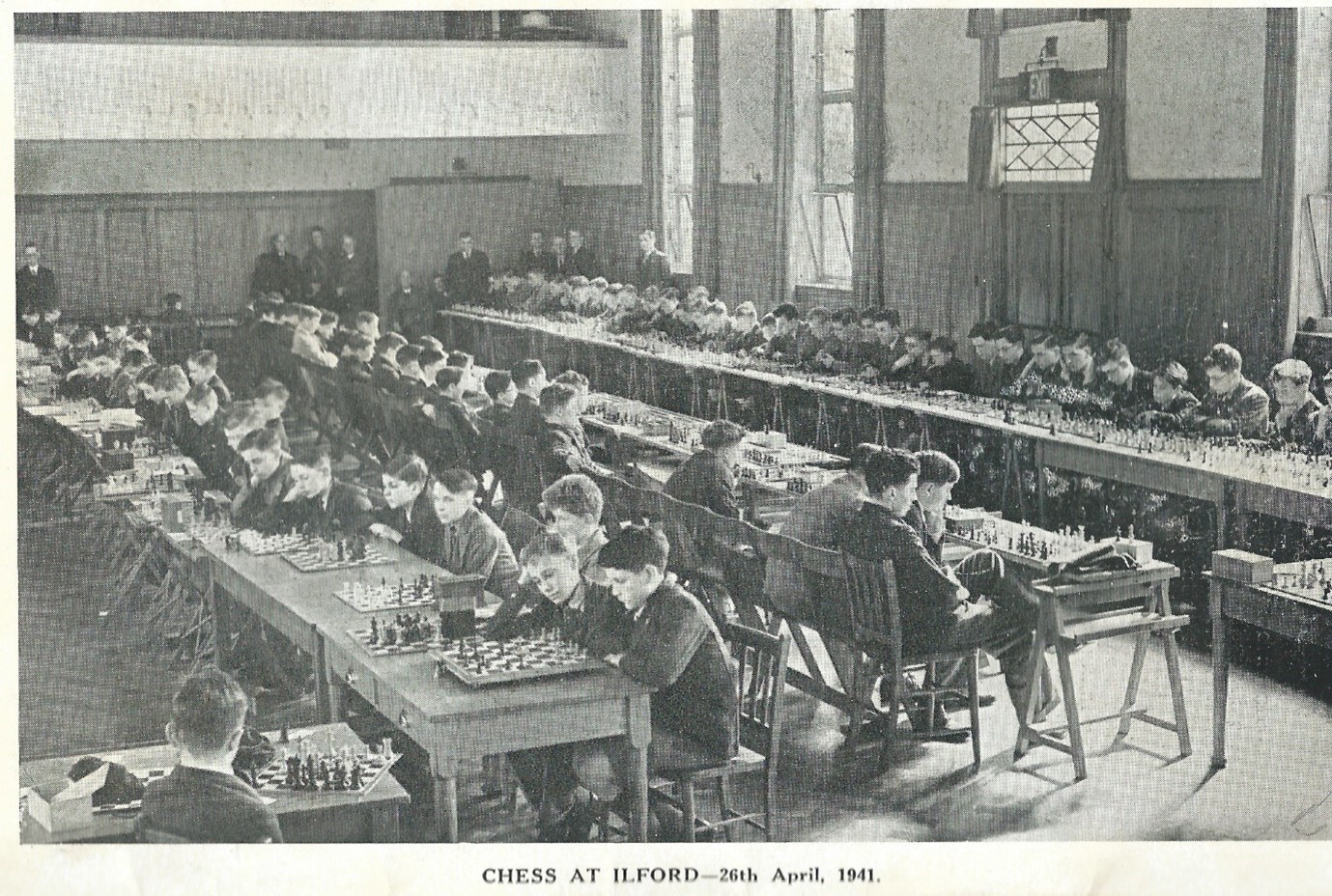
May Knight and her experiences of teaching at ICHS during the war.
As in the First World War, many of the Boys’ male teachers joined the Armed Services and there were staff shortages. Thus, for the first time, female teachers were employed to teach in the Boys’ School.
When the Ilford-based half of the ICHS reopened in September 1940, recently retired teacher, Mr Southgate returned as temporary Headteacher. He invited Ms Knight (Art) and Ms Turner (Chemistry) to join the staff. Despite initial concerns on the behalf of Mr Southgate that they, “looked no more than seventeen and he wandered how they would cope with lively boys,” they began a very successful time at the school. May Knight described her time at ICHS in her memoirs. She explained that 100 boys were expected on the first day of reopening. In fact 200 turned up and they were joined by a further 200 pupils by 1944.
May Knight described how prefects kept look-out on the School’s flat rooves during Art examinations. If aircraft were seen approaching, they rang a hand bell and all artists left the art rooms for safety. She also explained how after heavy air raids, volunteer Sixth Formers cycled to badly hit areas to check up on the welfare of absentees. She told the sad story of Dennis Hollands, a first year. He was absent for several weeks and letters to his home remained unanswered. After a couple of weeks, Mr Southgate went to Seven Kings to check up on him. A landmine had caused such devastation that hardly a house remained. The Hollands family had all died.
May Knight also described watching dog-fights over London and the prevalence of buckets of sand and stirrup pumps across the school to deal with incendiary bombs.
Ronald Youell- School Prefect and Firewatcher
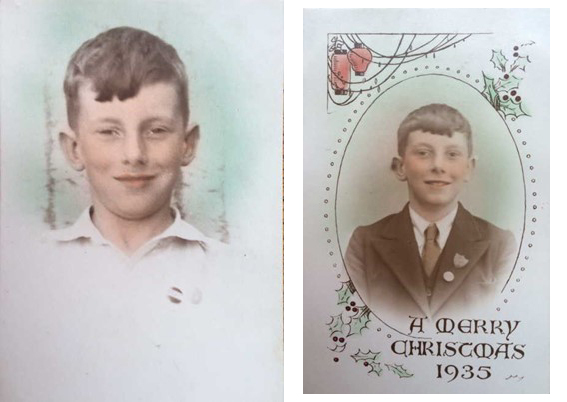
Photographs courtesy of Ronald’s daughter, Sarah.
Ronald was born in Battersea on 24th May 1925 and he attended ICHS between 1937 and 1943. It appears that he was evacuated with his mother and two brothers to Manor Farm, in Minehead, Somerset. However, by 1941, he was back in Ilford and at ICHS.
Ronald Youell wrote the following article for the school magazine in the Summer of 1941, describing one eventful night fire-watching at the school during the Easter holidays;
At about ten minutes before “blackout,” I cycled up to the Mossford Lane entrance and found it locked. I managed to get into the grounds through the “Casualty Service” entrance and the partition fence and then found all the doors locked. Luckily a pane of glass in one door was broken next to the bolt, and so I found my way into an almost dark building only to walk straight into a blast-wall in the corridor.
I found the three other fire-watchers in the Headmaster’s study and the office, and we settled down, hoping for a raid-free night. R----- and myself were in the middle of our first game of chess when the local sirens began to moan, and within half an hour of night-fall the latest example of Kultur was in full swing. From the shelter of the front porch we saw scores of yellow flashes in groups in the sky, where Jerry was (we hoped) feeling pretty uncomfortable.
At about 11 o’clock we saw a number of fires in the direction of Stratford and the City. There was a large number of vivid orange glares which lit up part of the sky for about six seconds, and started a discussion as to what kind of bomb they were.
Our local “incident” happened at 11.30 p.m. Overhead we heard an aeroplane. We had just started the usual discussion as to its nationality when every gun near us fired, and kept firing at it. We saw about 50 of the yellow fireworks at a spot right above us. There appeared a white glare from the direction of Dr. Barnado’s Homes, immediately followed by a faint swish and the crack of incendiary bombs hitting the ground. About 200 were unloaded over Barkingside by that Hun.
I saw a brilliant white glare in the quadrangle and rang the bell in short sharp rings and blew a whistle to give warning that the school had been hit.
We brought two stirrup pumps on the scene of action in half a minute, but unfortunately the valves had rusted and they would not work. The caretaker, Mr Allston, and his friend, who had heard the bell, appeared, each carrying a sand-bag, and the bomb, which was outside the side door of the Hall, was soon out. Then we lay flat on the Hall floor as four H.E. (High Explosive) bombs dropped near, probably aimed at the light of the bomb.
Meanwhile, the residents in Fremantle Road had extinguished the incendiaries on the open ground before the School, and the Casualty Service men had attended to those on the School field by shovelling turf on to them. After the incident we attended to the two pumps and got them working again.
We got no sleep that night; in addition to the noise outside, the camp-bed in the office folded up when I tried to sit on it and so I passed the night in an arm chair.
At about 12.30 the Rescue Party lorries went off to an incident in a nearby road, where three large bombs had badly damaged four houses.
Next morning we found in the quadrangle an incendiary bomb which had not ignited, and the Casualty Service took charge of it. Apparently, the incendiaries dropped were of the one kilo non-exploding type. We also discovered a large hole in the Hall roof where the bomb which we had put out, had rolled off. We collected the fins of a bomb as souvenirs.
I reached home at 8 a.m. and slept until 5 o’clock in the afternoon.’
On another evening a shower of 3000 incendiary bombs fell on Barkingside and the School. The firewatchers dealt with fires in both Quadrangles. Those lodged on the Hall roof had to be dislodged with poles to prevent them burning through the roof and setting fire to the wooden rafters. The next morning the prefects went out into the two Quads and collected up the metal fins of the bombs. In all, 146 fins were gathered.
A flying bomb (V1) fell near the cricket nets on the school field on the morning of July 27th 1944. It caused enormous damage to houses in Waterloo Road and the caretaker’s house as well as smashing a number of the school windows that faced the field. Fortunately, no one was hurt as it was during the school holidays.
Five overground air-raid shelters were built around the school (they have all since been demolished). The ground floor corridors were reinforced with staggered brick floor to ceiling blast walls at intervals. One former pupil recalled sitting an English Examination during an air-raid, in the sheltered corridors, and suffering pieces of plaster falling on his paper.
What ICHS boys contributed during the Second World War
Alongside the 115 names of boys and teachers who died in the First World War, there are 134 names of ex-ICHS students who died either in action or during bombing raids in the Second World War.
The war dead included soldiers, sailors and airmen who took part in almost every theatre of war across the globe. Others served in the merchant navy or coastal defence.
Of particular note is Jack Barrett, who took part in the famous Dambusters Raid. Sadly, his aircraft was shot down during the raid and he died.
The contributions of those who survived-a small sample of their stories
War work completed by Old Boys of ICHS ranged from serving in the forces or intelligence services to weapons and medical research vital for the wider war effort.
Some ex-pupils, like Arnold Hirst, who had fought in the First World War, used their experience to lead in the Second War. Arnold had served in the navy in 1916 and was appointed Engineer Lt-Commander in Malta in 1939. Other experienced sailors. like John Hearn undertook dangerous work escorting the merchant ships in convoy. Another merchant sailor, Cameron Browne served on the hospital ship, S.S. British Statesman.
Raymond Baxter remains one of the most famous Old Boys of the school. In 1965, he became the first presenter of the highly influential BBC TV programme, Tomorrow’s World. However, his war record was equally remarkable. He became a Spitfire pilot, aged 18 and served with 65, 93 and 602 Squadrons, instructed fighter pilots and made dive bomber raids on German V2 rocket bases.
Donovan Clibborn started the war in the Foreign Office in Genoa, before transferring to Bletchley Park. After this, he served with the Intelligence Corps in the Middle East. He was mentioned in dispatches “for gallant and distinguished services” in 1943 and later rose to the rank of Major.
Dennis Bones left ICHS in 1943 and joined the team developing Penicillin -the wonder drug of the Second World War. He worked at the top-secret Royal Navy Medical School at Cleveden, Somerset. It is estimated that over 100,000 soldiers’ lives were saved by Penicillin between D-Day and the end of the Second World War.
Pacifist Ronald Joynes studied at the Friends’ (Quaker) College in Birmingham, in preparation for joining the Friends’ Ambulance Unit. A fellow Old Boy, F. Marlow gave news of Ronald’s work in a letter to the school (it was published in Chronicles in the autumn of 1940). He wrote that:
‘At the commencement of the war, he (Ronald) joined the Friends’ Ambulance Unit and was attached to the British Red Cross. Upon completing his training he had an injection and this gave him a swollen arm, hence he left for Finland a few weeks after Lister (formerly the Headmaster’s secretary). He travelled to Helsinki via Newcastle, Bergen, Oslo and Stockholm. However, shortly after his arrival in the Finnish capital hostilities ceased. He remained in Finland, but upon the German invasion of Norway the ambulance unit hastened through Sweden to that country, where they did valuable work. When the British Government ordered the evacuation of troops from the Andalsnes and Namsos areas the unit proceeded to Namsos. On the way they suffered under the continual enemy bombardment. Then they reached a point where the road divided. Lister and his party took one route and Joynes and his party followed the other. Lister reached Namsos and boarded a British transport, but Joynes found that his road was blocked and so his party returned and followed the road taken by Lister. On the arrival at Namsos they found that the last British transport had left. It was then decided that his party should make a bid to reach Sweden. This was a most terrifying journey. The ambulances were driven through forests and over snow-bound roads. At last the party reached Sweden and they finally arrived at Stockholm, where I understand that Joynes is now doing hospital work. He is unable to return to this country, as it is necessary for him to traverse part of the U.S.S.R. and he has been refused permission to do this because he assisted Finland.’
Later reports that year gave news that he was subsequently able to travel to Egypt with his Ambulance Unit.
By June 1939, Malcolm Watson had collected three degrees and secured a post on the technical staff of Thomas Hedley & Co., a well-known soap firm in Manchester (which was later taken over by Proctor and Gamble). He was a chemical engineer. On 1st February 1940, he was transferred to a factory in Newcastle-on-Tyne in order to work on the production of Glycerine. It was reported in the Summer 1940 school magazine that he found his work at the Newcastle works as ‘rather exhausting’ although he described his firm as ‘marvellous and very go-ahead.’
According to Proctor & Gamble’s official company history:
‘In 1940 Procter & Gamble's packaging expertise was given military applications when the government asked the company to oversee the construction and operation of ordinance plants. Procter & Gamble Defense Corporation operated as a subsidiary and filled government contracts for 60-millimeter mortar shells. Glycerin also became key to the war effort for its uses in explosives and medicine, and Procter & Gamble was one of the largest manufacturers of that product.’
In the Spring 1942 school magazine, the following letter from Malcolm was published;
‘From February 1st I am leaving the Newcastle factory organisation to take up a special wartime position as the company’s Glycerine Recovery Adviser- the principle of this being the important one of ‘scrounging’ every last ounce of this chemical from our fats.’
Many more Old Boys and Staff of the school made vital contributions to the war effort and recently students took part in a joint Art-History project paying tribute to them.
ICHS After The War
Coping with a changing world; ICHS since 1945.
The 1950s saw a surge in new extra-curricular clubs at the school. Many of these reflected the cultural, scientific and technological advances of the period. For example, an Astronomical Society was set up and Radio, Railway and Photographic Societies established. By the 1960s, a Poetry Society and Jazz Society (advertised as informal with no need for regular attendance) were added. In addition, Unicef fundraisers and Youth Hostel trips were organised.
Some of the more traditional extra-curricular clubs also flourished after the Second World War. Photographs in the school’s archives and Chronicles accounts indicate that the Cadet Corps was very popular in the 1950s. A rifle range with a corrugated roof was built on the School field and the room next to the Headteacher’s office was known as the Armoury because it housed the Cadets’ rifles (and reputedly a machine gun!). The door was reinforced with five locks.
Recent developments to the School building
Since the late 1980s, science laboratories, additional technology rooms, a humanities wing and the four classroom annex affectionately known as the “Pizza Hut” were added to the original two-storey two quad building. The original gymnasium was converted into the Learning Resource Centre and a purpose-built Sports Hall was opened by Old Boy, Sir Trevor Brooking, in 2006. Famous alumni include other footballing notables such as John Lyall and the less famous but equally influential Ken Aston. Aston was a World Cup Referee in 1966 and he came up with the idea of Red and Yellow Cards.
Having guided the school through the Second World War and the upheaval caused by the 1944 Education Act, Mr Kenward retired in 1966. He was replaced by F. C. Young (1966-79). Subsequently, the School was led during the remainder of the twentieth century by Mr J. A. Evans (1979-86), Mr J. D. Moore (1986-1993) and Mr S. I. Devereux (1993-2009). Mrs C. Jordan was Acting Head between January and April 2010. Mr M. Capon took over from April 2010 until 2014. He was succeeded by Mrs R. Drysdale (2014-Present).
Centenary Celebrations-2001.
The School celebrated its centenary in 2001, with a series of events involving former pupils. A Centenary Cricket match took place at the Old Parks’ ground, attended by 450 pupils and staff. The ICHS First XI defeated the Old Parkonians XI in a closely contested match. The Centenary Football match saw special guests Clive Allen and Alan Curbishly feature for the Old Parks Select XI (alongside Staff members and Old Boys). They beat the School’s First XI by 8 goals to 5. Bramwell Tovey, the internationally renowned conductor and former pupil, oversaw a Summer Concert. A book of ‘now and then’ photographs was produced alongside a whole school photograph of the current pupils. The grand finale was a Garden Party on the school field.
Since 2001, the School has continued to expand, increasing from four-form to six-form entry. The Sixth Form has also grown. In 2017, a new Science Block with Sixth Form area was added.

